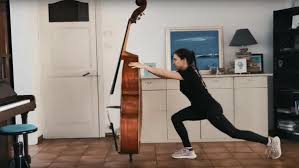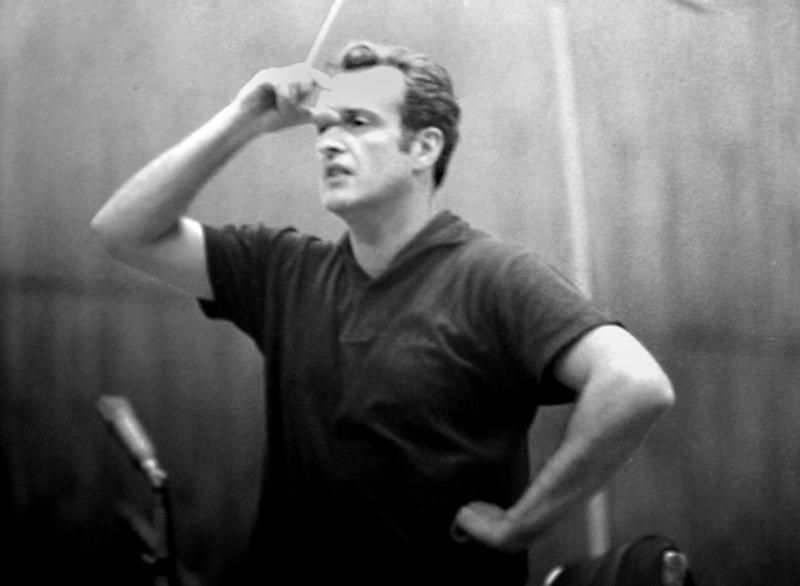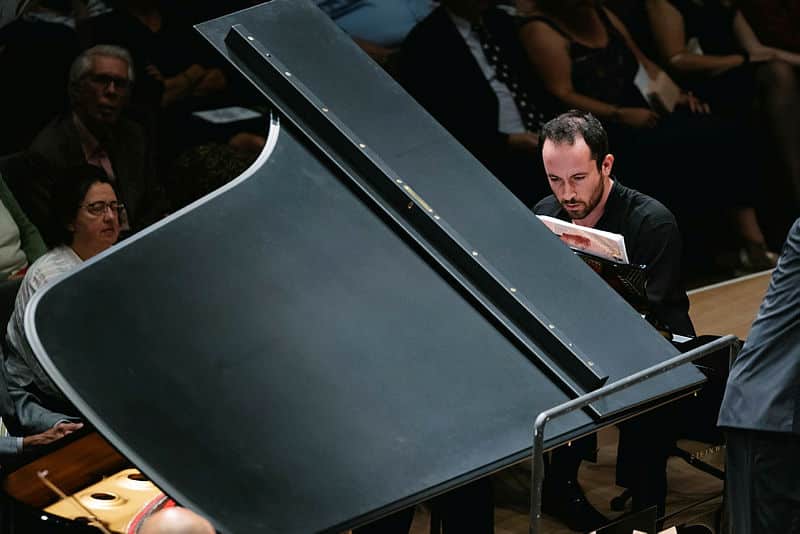Important: Berlin scientists issue rules for orchestra distancing
mainScientists at the Charité in Berlin have issued a 13-page paper, at the request of seven orchestras, advising the distances to be observed in rehearsal and performance for the forseeable future.
Briefly, it’s 1.5 metres between the seats of string players, 2 metres between winds.
The conductor should observe at least 1.5 metres from the nearest player.
The recommendations were provided at the request of the Berlin Philharmonic, DSO, Konzerthaus Orchestra, Orchestra of the German Opera and Komische Oper, Radio Symphony Orchestra and Berlin Staatskapelle.






“The conductor should observe…”
No change there for many.
But what about duration in the enclosed space and airflow of the ventilation system? Droplets travel much further in circulating air.
Then there’s the backstage, elevators, staircase, corridors, toilets, all that requires the same distancing.
You are right.
I don’t understand why people don’t just stick to a routing of buying a lot of toilet paper and going back home to their record collection until 2030.
Likewise, I wonder how exhaustive the research has been?
There are quite a few grey areas with regard to CV19. The strenuous debate about face coverings being just one case in point.
Under these conditions, most stages would not be big enough for a full orchestra. Someone should draw out what this would look like.
And the audience should sit outside of the hall.
These recommendation spell the end of orchestral music.
Imagine a similar panel in sports issuing the way athletes should plan a game.
This is mad, pure and simple.
End of orchestral music? Sounds like contingencies for live performances until there is a treatment/vaccine for COVID-19.
Same thing.
Exactly this: “These recommendations are temporary measures in an extremely exceptional situation.” (page 2, bottom)
The paper explicitely encourages resuming public performances: “Arts and culture are indispensable. At the individual level the arts support health and personal development, in particular music has healing effects. At the societal level arts and culture create identity, promote education and wellbeing. Thus it should be an urgent goal to relaunch them together with reopening industry, retail and education.” (page 3 bottom / page 4 top)
Finally a clear statement against the “this is dispensable luxury, thus let’s keep it closed until 2030” attitude which is, I think, no longer acceptable after the decision to clear the way for the almighty soccer still in May.
https://www.konzerthaus.de/media/filer_public/07/c1/07c103ca-b01b-47b3-8663-4cb48db9503e/stellungnahme_spielbetrieb_orchester.pdf
We are going to have to learn to live with the virus without either a vaccine or an effective treatment for it.
Hoping that this isn’t so and something will turn up just delays the moment when we face this reality.
Many thanks, Norman. We will use this as a guideline too. Robert Rÿker, Tokyo Sinfonia
I think we should all kill ourselves and be done with it. Life is just too damn dangerous. I have no idea how we made it to the 21st century anyway.
Most people didn’t make it to the 21st century.
Unworkable.
Whether it’s workable or not depends on the stage in question and the repertoire.
Well, it will rule out typical large-orchestra seating, but it will work for smaller pieces or creative staging.
What about the audience?
I am assuming the audience is non existent in these scenarios, and you’d be recording smaller ensemble repertoire for digital distribution. Maybe you could offer a perk to a few dozen big donors who want to sit in, spread out for the recording session? There would also have to be strict rules for people getting on and off stage. Most concert halls have labyrinthine corridors that don’t offer a lot of room to spread out backstage.
As with sex, mixing music with social distancing presents something of an issue.
How is it that string players can “safely” sit 1/2 a metre closer than winds? All other practical issues apart, the suggestion seems nonsensical. And even if it did not, it is impossible to imagine that musicians would be able to play with any degree of pleasure in the music or that anyone would pay for the privilege of hearing them attempt to do so. If the profession agrees to this it will be like choosing a slow and painful death over a quick one.
“How is it that string players can “safely” sit 1/2 a metre closer than winds? All other practical issues apart, the suggestion seems nonsensical”
Think about that for a minute and maybe it will come to you. Winds and brasses are blowing into their instruments. Spit is involved.
With even this distance between string players, sharing a music stand becomes impossible.
Because wind players blow masses of air out as they play. We string players breathe normally. I would think that’s fairly obvious!
I’ve sat next to plenty of string players that inhale and exhale like they are running an Olympic sprint. And that goes straight out without a mask.
And it’s not spit, but definitely between any gunk in the instruments and the condensation, whatever is emptied will surely not be appreciated.
At some point there just has to be a risk/reward evaluation and people will have to move on. Life will never be risk free.
Not going to work. Orchestras are either going to have to bite the bullet and go for it or resign themselves to a slow death.
“Going for it” is probably a more certain death. The amount of public outrage you’d generate by trying to put on a semi-normal concert would be huge. And then it’d only be a matter of time before someone got sick (whether it happened at the concert or not) and then files a lawsuit that could drain your endowment quickly.
It’s conceivable that still might actually happen going back into the last months, once things stabilize a bit in the USA and you start getting responsive litigations. But yes, this would be a sure fire social media disaster for any orchestra or hall and they know that.
There are going to be a bunch of people being hysterical whenever we “go for it”.
I’m, because all us Orchestral players careers, and livelihoods will be finished and there will be no more music.
The performance of Mahler’s 8th Symphony might present a problem if the rules of social distancing were to be followed.
This symphony requires 21 woodwinds (2 piccolos, 4 flutes, 4 oboes, 1 cor anglais, 3 B flat clarinet, 1 E flat clarinet, 4 bassoons, 1 contrabassoon); 24 brass (8 horns, 8 trumpets — 4 onstage and ¬4 offstage—, 7 trombones — 4 onstage and 3 offstage—, 1tuba); about 8 percussionists (tympani, bass drum, cymbals, triangle, tam-tam, bells, glockenspiel); about 3 or 4 keyboard players (organ, harmonium, piano, celesta); about 68 string players (16 first violins, 14 second violins, 12 violas, 10 cellos, 8 basses, 2 harps, 2 mandolins); 8 vocal soloists (3 sopranos, 2 altos, 1 tenor, 1 baritone, bass), 2 choruses (about 100 members each), children’s choir (about 100 members), 1 conductor.
Number of artists onstage: about 427. Number of artists offstage: 7.
The problem with the distance (whether 1.5 or 2 meters) concerns 427 artists; no real problem with the seven offstage brass players, who can comfortaby keep plenty of distance between themselves.
Now, what about pit orchestras when presenting, say, “Walküre” or “Elektra”?
Hey, they’re trying. Why give them so much grief? I much prefer full orchestra, but an interim alternative is certainly welcome.
I suspect once a reduced orchestra starts performing they will gradually creep closer as people realise it isn’t that dangerous. And the numbers on stage will gradually creep up. We just have to take the first steps.
All the comments are interesting, informative in thought. The more we keep talking the better chance of facing the challenges with possible solutions. I just keep practicing, teaching via Zoom (ugh!) and running through my mind how my orchestra will start come fall. This is going to take time and I suspect a great deal of chamber music, chamber orchestras, and solo performances while those big works wait in the wings to be rediscovered down the road, which could be exciting, to be sure. I was about to start rehearsals on Mahler 4 when COVID showed up, so, in the meantime, if we get this far, come fall I will divide the orchestra into four groups (one group per movement) and do the chamber orchestra arrangement al la the recommended distances. No question we will need to ‘extend’ our listening skills but hey, it’s a start. Musicians need each other.
Does anyone have a link to the study?
Read the other comments:
https://www.konzerthaus.de/media/filer_public/07/c1/07c103ca-b01b-47b3-8663-4cb48db9503e/stellungnahme_spielbetrieb_orchester.pdf
Looking for an official English version. For now, Google translate will have to do.